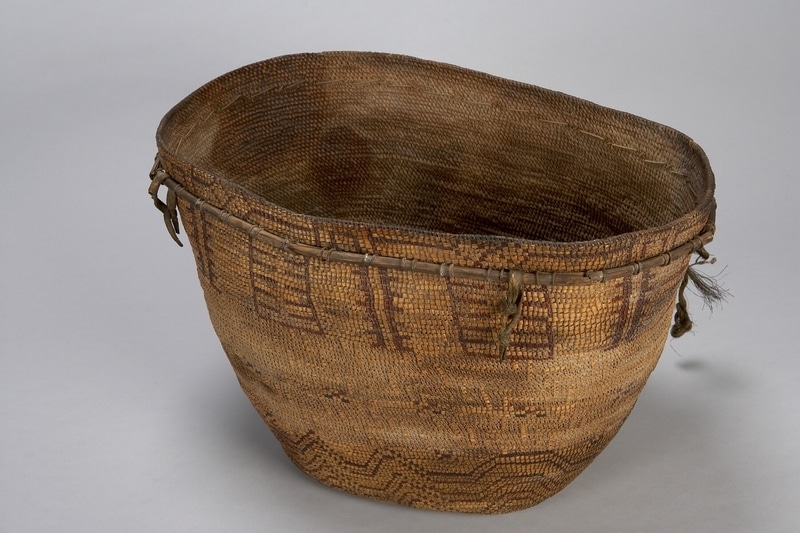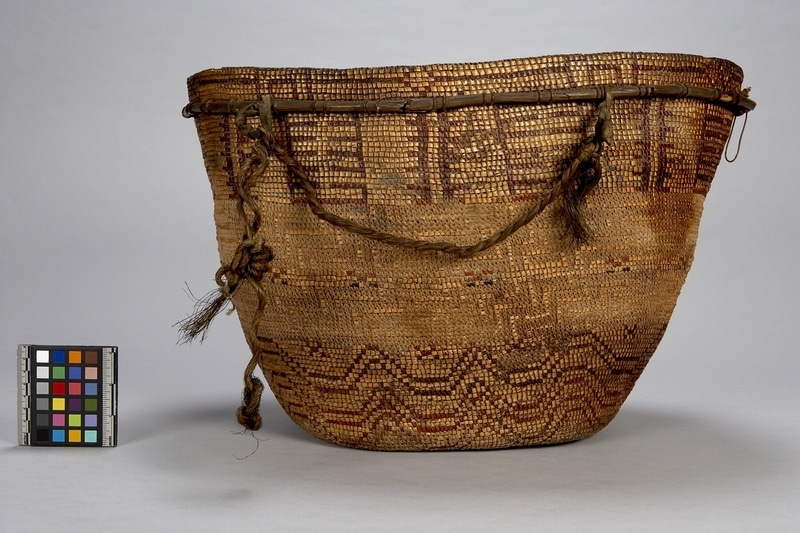Basket Item Number: Nd654 from the MOA: University of British Columbia



Description
Coiled basket with bifurcated stitches; parallel to watch-spring base construction; partially imbricated. The design from the bottom to top: three rows of double zigzags in red on bullrush ground; stepped pattern in bullrush; horizontal line with discrete shapes; one stepped pattern; discrete shapes on bullrush ground; concentric squares and double diamonds connected by horizontal line. Four rawhide ties; one twine tie and one braided fibre rope on the front. Colour: tan.
History Of Use
Coiled baskets in a range of sizes, embellished with distinctive patterns and motifs of animals and humans, have long been made and used by the Tsilhqot’in people. Spruce roots are usually preferred over cedar roots as the foundation for these strong and functional containers, which are often made in a flared, burden-basket form. Baskets were used extensively for carrying, storage and cooking, in addition to being made for trade or sale.
Specific Techniques
This type of basket was usually made of coiled split and bundled spruce-tree roots, stitched together by long, fine strands of spruce root. Beginning at the base of the basket, the weaver would gradually build up the form out of a continuous coil, stitching the upper layer to the coil below. Each stitch splits the one directly below it as the root is drawn through the coil. At the same time, the weaver folds or imbricates strands of grass and bark into each stitch on the outside of the basket, often creating dark patterns on a light background.
Item History
- Made in British Columbia, Canada
- Collected between 1885 and 1911
- Owned by Anna J. Beecher
- Owned by Frederick L. Beecher before 1952
- Received from Frederick L. Beecher (Donor) during 1952
What
- Name
- Basket
- Identification Number
- Nd654
- Type of Item
- basket
- Material
- rawhide skin, cherry bark, cedar root, cedar wood, cat-tail grass ? and fibre
- Manufacturing Technique
- coiled and imbricated
- Overall
- height 31.7 cm, width 48.5 cm, depth 31.3 cm
Who
- Culture
- Tsilhqot'in
- Previous Owner
- Anna J. Beecher and Frederick L. Beecher
- Received from
- Frederick L. Beecher (Donor)
Where
- Holding Institution
- MOA: University of British Columbia
- Made in
- British Columbia, Canada
When
- Collection Date
- between 1885 and 1911
- Ownership Date
- before 1952
- Acquisition Date
- during 1952
Other
- Item Classes
- basketry
- Condition
- fair
- Current Location
- Case 30
- Accession Number
- 2004/0198